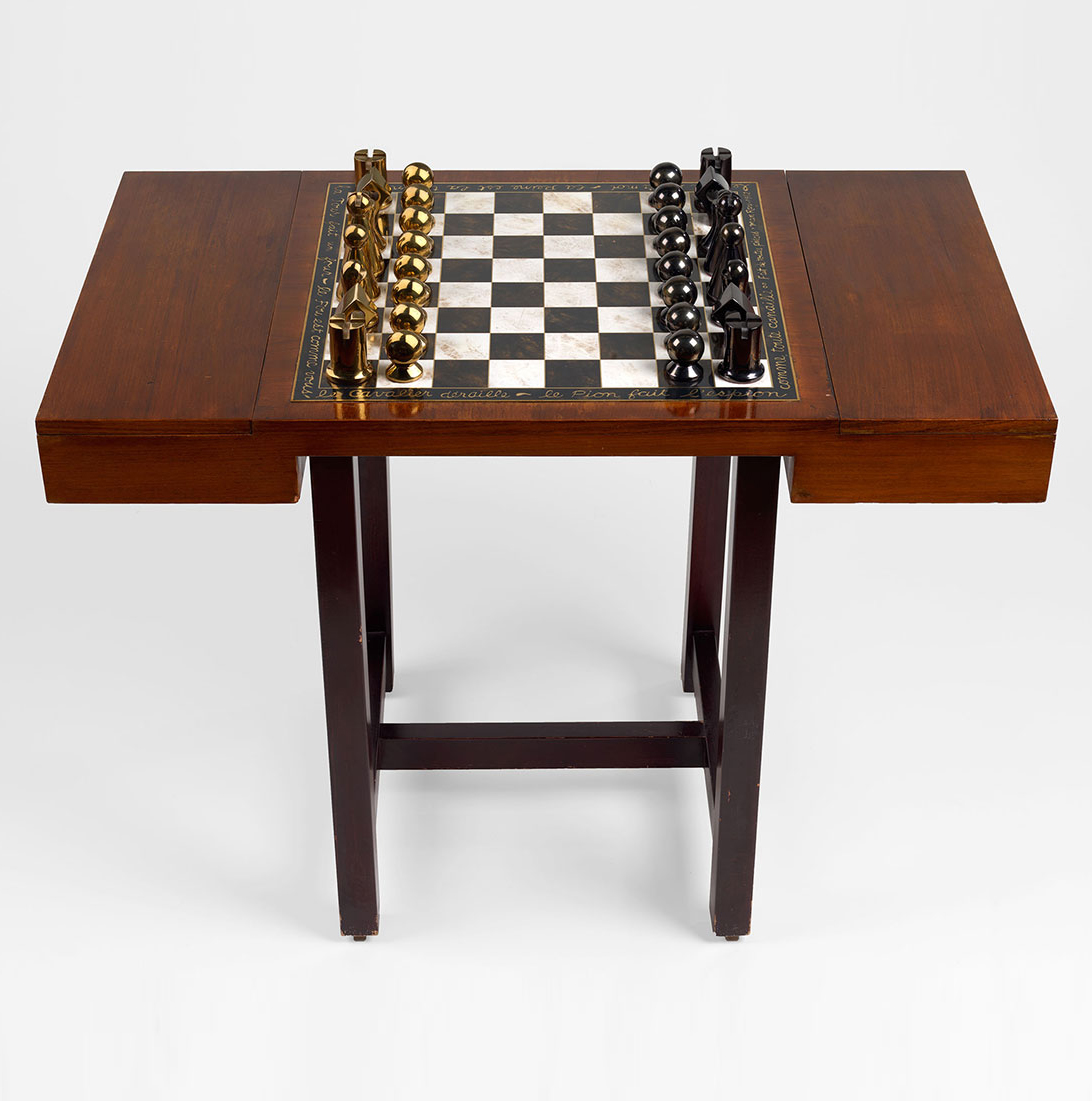Edouard Sebline
le Roi est à moi – la Reine est la tienne
la Tour fait un four – le Fou est comme vous
le Cavalier déraille – le Pion fait l’espion
comme toute canaille ·· Fait de toutes pièces
Man Ray – 1962
the King is mine – the Queen is yours
the Rook is a fiasco – the Bishop is like you
the Knight is off the rails – the Pawn is a spy
like every scoundrel ·· Made out of thin air
Man Ray – 1962
Man Ray’s poem in French inlaid around the edge of the board of his 1962 chess set introduces an element of human drama into the game of chess, transforming it from cerebral game of strategy into a piece of theatre. A riddle that confounds as much as it intrigues, this text represented the latest innovation in Man Ray’s chess designs as they evolved from their first iteration almost 50 years earlier. Man Ray was not alone within avant-garde circles in finding inspiration in the game of chess. Yet he was arguably the foremost maker of chess sets among artists of the 20th century. His interest in a game relying on a strict set of rules may appear at odds with his desire for the freedom to transcend social and artistic conventions. Yet he believed that the chessboard was “a field for clear thinking, impromptu imagination, surprise, planning for the abstract.”1
Man Ray taught himself chess from a book as a boy, but it was his friendship with Marcel Duchamp that really developed his interest in the game. At the time of their meeting in 1915, Duchamp spoke no English, and Man Ray’s French was non-existent, so the universal language of chess may have helped cement their friendship.2 In New York in 1920-1921, as they began to collaborate artistically, they frequently played together at Marshall’s chess club on 4th Street.3
Man Ray conceded in his autobiography that he was a “third-rate player”, but that his “interest was directed towards designing new forms for chess pieces … to me a fertile field for invention.”4 His earliest-known chess set, made in 1920, consisted of “unorthodox pieces, simple geometric shapes.”5 Arturo Schwarz writes that Man Ray appropriated artist’s tools and other objects for his design, “items scattered around his studio – simple geometric wooden shapes used as draughtsman’s models and broken violins left over from a storage house.”6 The King was represented by a pyramid, a cone became the Queen and a cube the Rook, while the Bishop was a bottle form and a sphere glued to a button used for the pawn. The Knight was formed from the sawn-off scroll of a violin.
When he moved to Paris in 1921, Man Ray took his chess set with him, and in 1926 was commissioned by the Maharajah of Indore to create a larger version in silver (three examples were made). By then Duchamp had all but given up making art in favour of playing chess. He introduced Man Ray to the world champion, Alexander Alekhine, in the hope that he might assist with the design being put into production. This endeavour ultimately failed, with Man Ray concluding that “chess players were not susceptible to form, unless they were also artists.”7 Nevertheless, when living in Hollywood in the 1940s, he began again in earnest to make new sets in wood and more advanced materials such as anodised aluminium, and again in Paris in the 1960s and 1970s, each new design evolving from the original 1920 set.

Chess Set and Table
Chess set comprising thirty-two bronze pieces, sixteen patinated in black and sixteen patinated in gold, with an enamel and metal inlay board set on a wood tabletop with lidded storage compartments for the chess pieces.
Designed in 1962 and executed between 1962 and 1966 in an edition of 50 plus 5 artist’s proofs (Marcel Zerbib, Paris).
Inscribed Man Ray and numbered 21/50 (on the white king); inlaid with the artist’s poem in French in his handwriting (around the perimeter of board).
King: height 10 cm. Tabletop: width 57.1 cm; length 99.1 cm; height 9.9 cm.
Provenance:
Personal collection of Arturo Schwarz, Milan (acquired from the artist in 1964).
The present set was likely acquired by Arturo Schwarz after a visit to the artist in Paris in October 1964,8 and Schwarz recalled that on occasion he and Man Ray used this set to play each other.9 For Schwarz, “Man Ray, like Duchamp, must have been attracted by the deeper implications of chess … a secular projection of mythical contests and sacred games.”10 Man Ray certainly remained an enthusiastic player throughout his life, perhaps more importantly he considered his sets to be “a work of art … a sculpture of many parts.”11 Originally consisting of found and reconstructed objects from the artist’s studio, Man Ray’s chess sets are eloquent expressions of the intersection between art, geometry, poetry and games.
Edouard Sebline
Literature (selected):
Man Ray (exhibition catalogue), Museum Boymans-Van Beuningen, Rotterdam; Musée National d’Art Moderne, Paris & The Louisiana Museum of Modern Art, Humlebæk, 1972, no. 147, illustration of another example from the edition p. 73.
Jean-Hubert Martin, Rosalind Krauss & Brigitte Hermann, Man Ray; Objets de mon affection, Sculptures et Objets, Catalogue raisonné, Paris, 1983, illustration of another example from the edition p. 161.

If you would like to stay up to date with exhibitions and everything else here at Prahlad Bubbar, enter your email below to join our mailing list